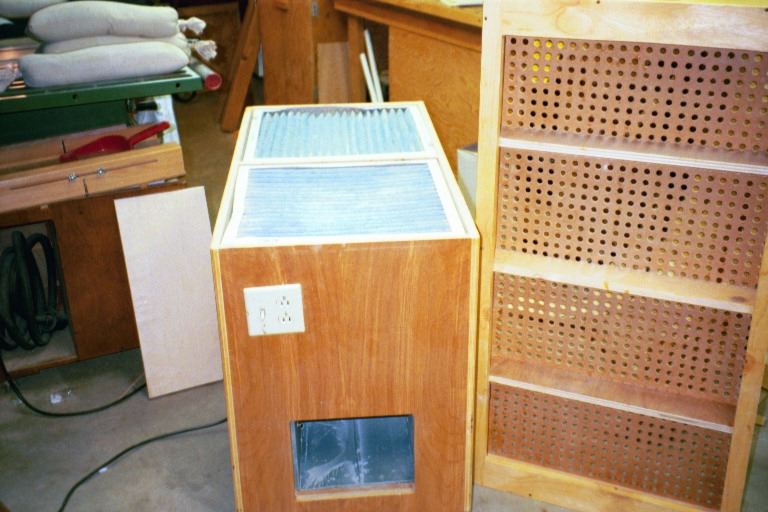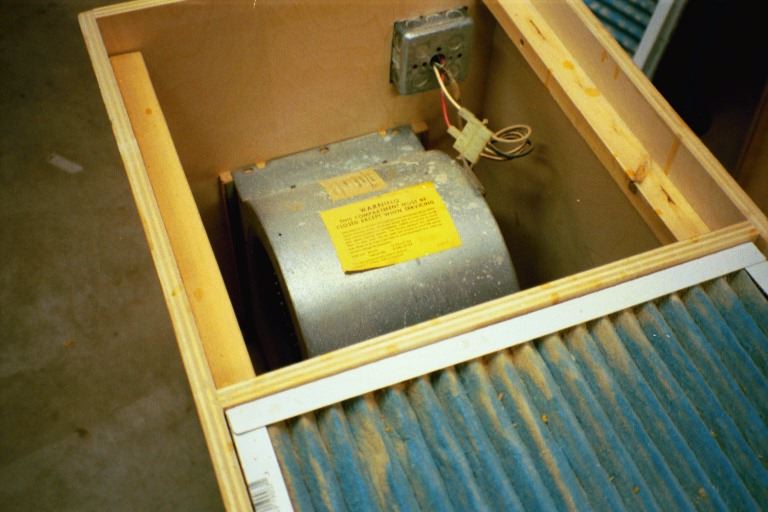
Sanding Dust Collector Table
By Bill Schertz, KIS Cruiser #4045
Before I embarked on building an AIRPLANE, I used to do wood working as a hobby. Some of the skills are related, for instance you do a lot of SANDING and making DUST in both. To lower the dust load in my workshop, I constructed a filtering sanding table that removes the dust from sanding before it goes into the air. I have used this extensively in the fabrication of my kit, putting anything that needs sanding on it. Some pictures are included to add to the description.
To build this, you will need:
1 - 4' x 8' sheet of plywood, 3/4 inch thick.
1 - 2' x 4' sheet of perforated hardboard, 1/4 inch thick
1 - squirrel cage blower/motor from an old furnace (free - just talk to a HVAC repairman, and ask for one)
? - some miscellaneous scraps of wood.
4 - 20" x 20" pleated furnace filters 1" thick.
An overall view of the unit is shown in the photo (Sanding Table.jpeg). the 3/4" plywood is used to construct a open topped box that houses a furnace blower. You can see the blower exit, a switch plate for turning the table on, and a couple of plugs for plugging in my sanders. The top is the perf board, and I have enlarged the holes to 1/2" for better breathing. I also painted the top with a polyurethane varnish (two coats) that hardens and toughens the perf board, and makes it very slick. The black sheet that is sitting on the back half of the top is a porous rubber mat that I picked up at a wood working show. Lets the sawdust go through, and prevents things from skidding around the top. It is big enough to cover the entire top, I just pulled it back for the picture.
 |
Also you can see my belt sander on the table. With the table blower running, the dust from the belt sander just disappears into the table and doesn't enter the shop.
The next photo shows the unit with the top removed (top removed.jpeg). You can see the furnace filters in place, and the cross braces for the perforated top. Also, the rim around the perf top was sized so I could get a full 2' x 4' surface, and still build the box enclosure with only one sheet of plywood. The filters are 1" thick, and I stack two on top of each other to give a 2"filter. Much cheaper.
 |
The next photo (Blower/filter.jpeg) shows the internal workings of the unit. The blower is just mounted so that the exhaust blows out of the box, creating a suction below the filters. The filters rest on a wooden ledge. You can see some material on the filter medium, and I periodically vacuum off the accumulated dust from the filters, rather than purchasing new ones.
 |
I cannot stress strongly enough the difference this makes. I even turn it on when not working on sanding because it acts like a fan for the shop, and if I have done an operation (like with my table saw) that generates a lot of dust or smoke in the shop, this unit will remove it from the air very quickly.
It is on casters so I can move it around, and is height-wise just right for acting as an out-feed table for my table saw (added benefit).